Losing weight and keeping it off can be a struggle.
Especially if you have an underactive thyroid. Your metabolism has slowed down and you’re almost always feeling tired.
But if you break down the process into small steps, and tick each box as you go, weight loss comes much easier.
This guide covers the 6 fundamental steps required to successfully lose weight with an underactive thyroid.
1. Optimise Your Thyroid Medication
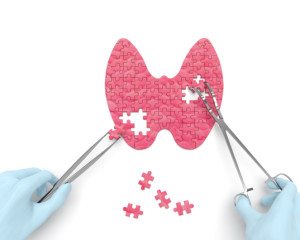
I wanted to begin with a nutrition recommendation, but correcting your thyroid medication first priority.
If your medication is not helping to correct TSH and your T3 and T4 thyroid hormone levels, as well as relieve symptoms, then weight loss goes from difficult to impossible.
Work with your health care provider to determine what type of medication is better for you, and also to find the optimal dose required. While Levothyroxine is on average more effective, Armour is reportedly much better tolerated.
There is no difference between taking your thyroid hormone meds in the morning vs evening. Choose whatever is easier for you to have it on a fasting stomach (1, 2).
Summary: It is fundamental to work with your doctor to explore what type and dose of thyroid medication is best for you. Until your thyroid hormone levels are corrected, weight loss is much more difficult.
2. Cut Back on Added Sugars and Refined Starches

I need to begin with this clarification:
Carbohydrates are not inherently bad for you. That is, they do not make you fat or sick on their own (I wrote in detail about it here). It always comes back to total calories consumed.
That said, carbs in the form of added sugars and highly refined starches are unhealthy and unnecessary. They offer almost zero nutritional benefit (known as “empty calories”) and make up a large portion of the excess calories we consume.
In fact, the average American adult’s consumption of added sugar increased by more than 30% in the last 30 years, with children consuming approximately 20% more. This was illustrated below by Obesity.org.
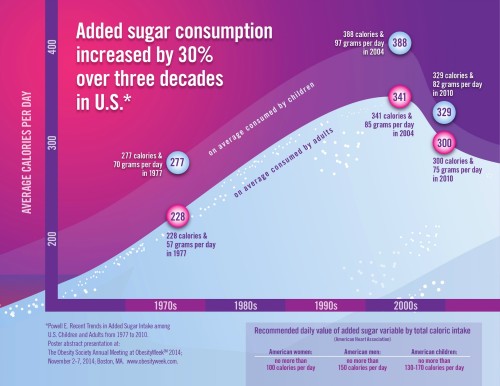
Fortunately those numbers have began to reverse; a trend that needs to continue. Nevertheless, cutting back on added sugar is still the most simple and direct way to cut out excess “empty” calories.
This is done by limiting intake of junk foods, flavoured drinks (including juice), alcohol, white bread, most cereals and muesli bars, and a good portion of packaged food in your supermarket’s “health food” aisle. That includes gluten-free junk food… it’s still junk food.
Now it’s unrealistic (and unfair) to expect yourself to completely avoid added sugar every day of the year. But you need to begin taking actionable steps that help you cut back and form healthier habits.
Start by not having junk foods at home, or at least keep them out of sight in a cupboard you never use.
Summary: Added sugar makes up a large portion of the excess calories an average person consumes each day. Cutting down on your intake is critical if you want to successfully lose weight.
3. Base Meals Around Vegetables and Protein
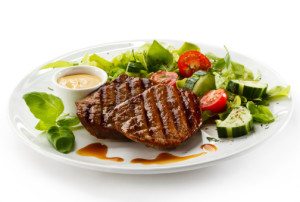
If you want to lose weight with an underactive thyroid, these should be the foundation of almost every meal you make, and plated first when serving.
There are 2 main reasons for this:
1. Protein is paramount for weight loss
The main benefit of protein is that it’s much more satiating than both fat and carbs. That is, it has a unique ability to reduce appetite and therefore your overall caloric intake too.
Studies show high protein diets may also reduce obsessive thoughts about food by 60% and cut desire for late-night snacks by half (3, 4).
Foods high in protein include meat, seafood, eggs, nuts, legumes (beans) and dairy.
Protein is also the muscle-building nutrient, so a high protein diet complements regular exercise.
2. Vegetables provide most vitamins, minerals and other micronutrients
The nutrient-density of meals is even more important for those with hypothyroidism and other autoimmune diseases, where nutrient absorption and deficiency are more common.
Emphasis goes to green leafy vegetables, mushrooms and cruciferous vegetables like broccoli, cauliflower and cabbage.
Veggies are also our greatest source of fiber, a nutrient that feeds the healthy bacteria in our gut. Studies show that long-term low fibre intake will completely throw out the balance of your gut bacteria; the effects on the gut health of mice was irreversible (5).
Fiber supplements are also an option if you want to be extra sure you are meeting your requirements.
As a general guide, the protein portion of your meal should be the size of your palm, and salad/vegetables the size of your hand. This would leave about 1/4 or less of your plate for carbs (such as rice or potato or pasta).
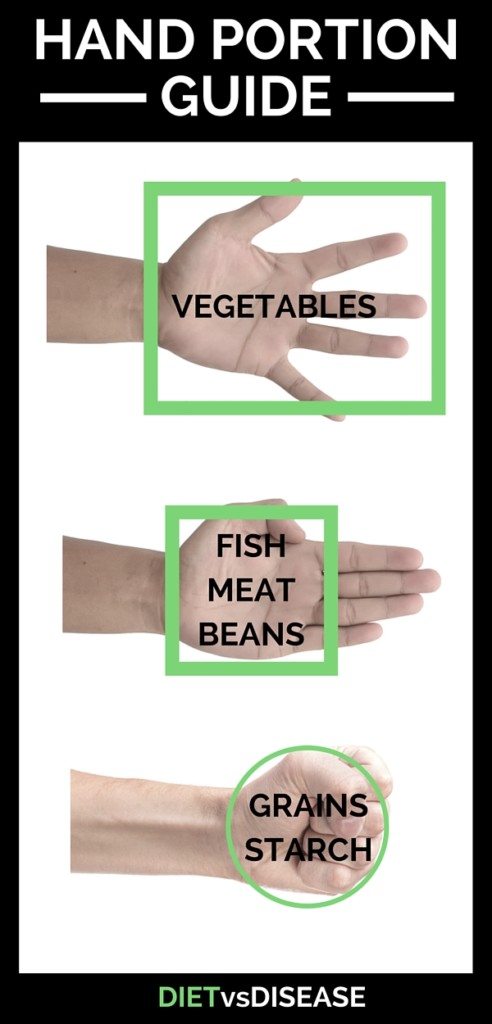
Summary: Protein foods and vegetables should make up the majority of your plate. They are generally the most filling and/or nutrient-dense foods per calorie.
4. Increase your intake of Selenium and Zinc
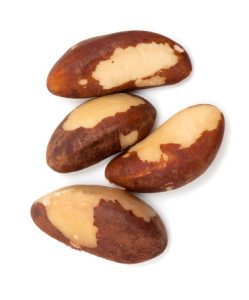
Selenium and zinc are two nutrients directly involved in thyroid function.
It’s critical that a diet for hypothyroidism contains adequate quantities in order to optimise thyroid hormone production and metabolism.
Selenium
Selenium is an essential mineral that helps the body to recycle iodine. That’s the reason the thyroid has the highest selenium content (per gram of tissue) of all our organs (6).
Therefore, it’s thought that low selenium levels contribute to hypothyroidism through alternate mechanisms related to iodine. For this reason it’s fundamental to eat a diet that contains many selenium-rich foods, such as:
- Brazil nuts
- Tuna and sardines
- Beef and chicken
- Eggs
- Legumes
Zinc
Zinc is an essential mineral required to regulate Thyroid Stimulating Hormone (TSH).
In fact, the metabolism of zinc and thyroid hormones are closely interlinked, which is why a deficiency can lead to alopecia (hair loss) (7).
While zinc deficiency is very uncommon in the developed world, it’s still recommended to eat a variety of zinc-rich foods (8). This includes:
- Oysters and shellfish
- Beef and chicken
- Legumes, nuts and seeds
- Milk and yoghurt.
Iodine is also important for thyroid health, but in reality insufficient iodine levels that can harm the thyroid is extremely rare in developed countries (9).
You’re much better off focusing on selenium and zinc-rich foods, many of which contain iodine anyways.
Summary: Consuming a diet naturally rich in selenium and zinc is critical for maintaining a healthy thyroid and metabolism.
5. Take regular walks or start lifting weights each week

“You can’t out-exercise a bad diet.”
This is true, especially when your metabolism is slower than normal. That’s why this article places so much emphasis on dietary changes.
However, if you want to kick-start your weight loss then regular exercise is the best way to do it.
Weight loss ultimately comes down to expending more energy (calories) than you consume. Although it’s much more complex than “eat less, move more” (there are many biological factors to consider), being active helps to burn additional calories. It also improves aspects of health that even perfect nutrition can’t provide, such as strength and mobility.
You don’t have to put yourself through miserable high-intensity workouts either. Research shows that low-intensity exercise that lasts longer – such as regular long walks – are just as effective for weight loss, especially if you are just starting out (10).
A general guideline is to walk for at least 60 minutes or 10,000 steps on most days.
Unable to do cardio exercise
Regularly lifting weights (or bodyweight exercises) is also highly beneficial, especially if mobility is an issue for you. In fact, it’s equally as important as cardio and we should be doing both where possible.
Known as resistance exercise, it still helps burns additional calories, but with the added benefit of building lean muscle. The more muscle you have, the faster your metabolism and the less likely you are to fall ill (11).
There are numerous resistance exercise programs on Youtube for beginners, and you can do it all at home if you invest in a pair of dumbbells or even one kettle bell.
Summary: Regular exercise helps to kick-start weight loss and speed up the entire process. It also improves your strength, mobility and metabolic health. If mobility is a problem for you, lifting weights or bodyweight exercises are a fantastic alternative.
6. Trial The Autoimmune Protocol Diet (Optional for Hashimoto’s)

This step is only for those with Hashimoto’s or another autoimmune disease, and only recommended if you already consistently follow steps 1 to 5 but are still very overweight.
The Autoimmune Protocol (AIP) is an elimination diet that temporarily cuts out numerous food groups including dairy, grains, nuts and seeds, legumes, nightshade vegetables and more. It is said to have emerged from the Paleo movement (and sometimes referred to as Autoimmune Paleo), but to describe it as Paleo seems too basic.
The AIP goes by the premise that certain food chemicals and compounds cause low-grade inflammation in the gut of individuals with an autoimmune disease (in this case Hashimoto’s disease). Low-grade inflammation appears to be a driving factor behind many modern health conditions, including autoimmune diseases, metabolic disorder and obesity too (12).
By removing the everyday trigger foods in your diet, inflammation subsides giving your body the opportunity to recover and “reset”; known medically as remission. This is what occurs in celiac disease patients when they remove gluten from the diet, or most IBS patients following a low FODMAP diet.
Is It Evidence-Based?
I’ll admit I was highly sceptical of this theory at first; researchers in the area of rheumatology/immunology rarely do randomised trials on elimination diets (the only way to prove “cause and effect”). That means we still cannot reliably say what foods influence autoimmune diseases and their symptoms (nor to what extent).
Does it help because you cut out specific trigger food components? Or because such restriction inadvertently forces you to eat healthier consistently? Or is it a combination of both? It’s hard to say, but we cannot ignore the abundance of non-trial and anecdotal evidence (personal testimonial) that indicate AIP helps with a variety of symptoms.
Although only temporary, elimination diets like AIP are highly restrictive and can get complicated if you take medications for other medical conditions or are at risk of nutrient deficiencies. It’s fundamental you speak with your doctor before beginning.
Summary: Trialling the Autoimmune Protocol is an option if you have Hashimoto’s disease and have found steps 1 to 5 are no help. It may help with weight loss given its (theoretical) influence on inflammation and its highly restrictive nature.
Additional Tips to Lose Weight With An Underactive Thyroid
Here are some extra pointers to help you lose weight with an underactive thyroid:
- Prioritise sleep: Alongside poor diet and exercise, short sleep duration is one of the strongest risk factors for obesity. Good quality sleep is fundamental for weight loss.
- Thyroid support supplements: Anecdotal reports suggest supplements can give you more energy, at least for the first few months of use. But they’re likely unnecessary if you regularly eat nutritious foods.
- Use smaller plates and small spoons: Studies show the bigger the plate and the bigger the cutlery, the more calories we consume (13). This proven phenomenon is called the Delbouef illusion.
- Plate your meals first: Instead of putting all the prepared food at the table (like a buffet), plate your meal first and then sit down. You are much less likely to go for a second (or third) round.
- Drink lots of water: Keep a water bottle on hand wherever you go. Research suggests the more water we drink before meals, the fewer calories we eat overall (14).
- Be mindful: Mindful eating is about becoming more aware of your experiences, physical cues and feelings about food. It is based on a form of meditation called mindfulness.
